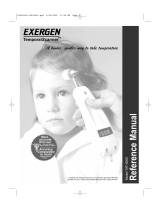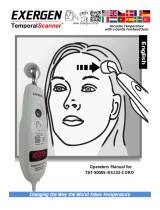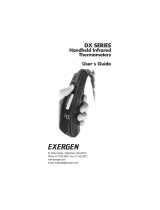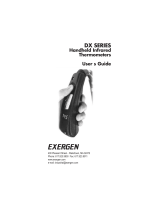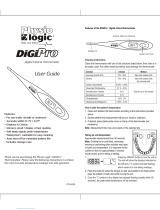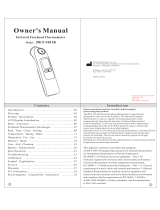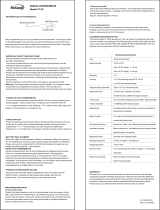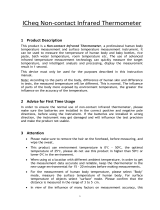Page is loading ...

TemporalScanner
TM
2000C
EXERGEN
Quick Check-List:
- Read instructions completely
before using
- See www.temporalscanner.com
for Educational Video
- Remove protective cap before using
- Reads arterial temperature, which is
a core temperature very close to
rectal temperature (See pg. 9)
- Sensor should be clean (See pg. 12)
- If perspiration is present see pg. 7
Temporal Artery Thermometer
Instructions For Use
1
2
tat2000instrev6.qxd 2/6/2006 9:35 AM Page 1

READ ALL INSTRUCTIONS BEFORE USING
When using the product, especially when children are present, basic
safety precautions should always be followed, including the following:
z This product is intended for household use only. For information
on thermometers for professional use, please see www.exergen.com,
or call 617-923-9900.
z Use this product only for its intended use as described in this manual.
z Use of this product is not intended as a substitute for consultation with your
physician.
z Do not take temperature over scar tissue, open sores or abrasions.
z Basic safety precautions should always be observed, especially
when this product is used by, on or near children or invalids.
z The operating environmental temperature range for this product
is 60 to 104°F (15.5 to 40°C).
z Always store this thermometer in a clean, dry place where it will not
become excessively cold (-4°F/-20°C), or hot (122°F/50°C).
z The thermometer is not shockproof. Do not drop it or expose it to
electrical shocks.
z This thermometer is not intended to be sterile. Do not try to sterilize it.
Follow the cleaning instructions as described in this manual.
z Do not use this thermometer if it is not working properly, if it has been
exposed to temperature extremes, damaged, been subject to electrical
shocks or immersed in water.
z There are no parts that you can service yourself except for the battery,
which you should replace when low following the instructions in this
manual. For service, examination, repair, or adjustments, return your
thermometer to Exergen.
z Do not operate where aerosol spray products are being used or where
oxygen is being administered.
z Do not take temperatures with this thermometer near places that are
very hot, such as fireplaces and stoves.
z Do not use this thermometer outdoors.
z Never drop or insert any object into any opening.
Important Safety Instructions
2
tat2000instrev6.qxd 2/6/2006 9:35 AM Page 2

z If your thermometer will not be used regularly, remove the battery to
prevent possible damage due to chemical leakage. If the battery leaks,
remove carefully. Do not allow bare skin to touch leaking fluid.
z Dispose of used batteries properly. Do not wrap them in metal or
aluminum foil. Wrap them in newspaper before disposing of them.
Do not burn them. Battery may explode if overheated.
SAVE THESE INSTRUCTIONS.
Congratulations and thank you for purchasing the Exergen TemporalScanner
Thermometer for consumer use. Your new TemporalScanner Thermometer
is a totally non-invasive system with advanced infrared technology providing
maximum ease of use with quick, consistently accurate measurements.
Advanced, patented technology measures temperatures with a gentle
stroke across the forehead.
The TemporalScanner Thermometer has been clinically tested for accuracy com-
pared to rectal thermometers and temperature sensors inserted in the heart dur-
ing course of patient treatment
2
and accepted for use in major hospitals, making
it the ideal thermometer for use with newborns, infants, children or adults.
Table of Contents
Important Safety Instructions 2
Introduction 3
Before Using, Familiarize Yourself With the Instrument 5
Measuring TA Temperature 6
How to Take a Temperature 8
Clinical Temperature Information 9
Cleaning the Instrument 12
Changing the Battery 13
Display Messages, °C/°F Conversion 14
Product Specifications 15
Warranty 16
Introduction
3
tat2000instrev6.qxd 2/6/2006 9:35 AM Page 3

The TemporalScanner has patented software, providing arterial heat balance.
This unique process determines temperature by accurately measuring the
balance between the tissues warming from arterial blood and tissues cooling/
warming caused by heat loss/gain to the environment.
Why take temperature measurements at the skin surface
over the temporal artery?
The best place to measure temperature is the center of the heart, but this
can be done only under a doctor’s supervision. Doctors know that measure-
ment of the blood temperature in a major artery accurately reflects true
body temperature. The TemporalScanner Thermometer is designed to
measure the temperature of the skin surface over the temporal artery, a
major artery of the head.
The temporal artery is connected to the heart via the carotid artery, directly
leading from the aorta, the main trunk of the arterial system. It offers con-
stant blood flow. It is the only such artery positioned close enough to the skin
surface to provide access needed to take an accurate measurement. It is
easy to use because it is ideally located at the front portion of the forehead.
The TemporalScanner is easier and gentler to use than other types of meas-
urement devices such as oral, rectal, underarm and in-ear thermometers
because it is truly non-invasive.
How does the TemporalScanner Thermometer work?
As you gently stroke the thermometer across the forehead crossing over
the temporal artery, the sensor in its probe performs two processes:
First it scans like a video camera, capturing naturally emitted infrared heat
from the arterial blood supply at about 1000 times per second, locking in
the highest temperature it senses and;
Second, at the same time, a patented system measures the ambient tem-
perature of the area where the temperature is being taken. The patented
“arterial heat balance” (AHB) software then synthesizes the two separate
readings to accurately determine and display body temperature.
As with any thermometer, taking temperatures properly is critical to obtaining
accurate temperatures, so please read all instructions carefully and thoroughly
before using this product.
4
tat2000instrev6.qxd 2/6/2006 9:35 AM Page 4

5
Probe Cone
Probe Sensor Lens
Probe
LCD Display Screen
LED Indicator Light
SCAN Button
Automatic
turn-off in
30 seconds
LED Indicator Light
Thumb-Push Ridges
Battery Compartment
9-volt alkaline battery
z To Scan: Depress the button. The instrument will continually scan for
the highest temperature (peak) as long as the button is depressed.
z Beeping and LED flashing: Beep and LED flashing indicate a rise to a
higher temperature, similar to a radar detector. Slow beeping indicates
that the instrument is still scanning, but not finding any higher temper-
atures.
z Retain Reading: The reading will remain on the display for 30 seconds
after the button is released.
z To Restart: Depress the button to restart. It is not necessary to wait
until the display is clear, the thermometer will immediately begin a new
scan each time the button is depressed.
Before Using, Familiarize Yourself with the Instrument
Protective Cap (remove during use)
tat2000instrev6.qxd 2/6/2006 9:35 AM Page 5

What you should know before using the TAT:
z Measure only the side of the head exposed to the environment. Anything
covering the area to be measured (hair, hat, wig, bandages) would insulate
the area, resulting in falsely high readings.
z Slide the thermometer straight across the forehead, not down the side
of the face. Midline on the forehead, the TA is about a millimeter below
the skin, whereas at the side of the face, the TA is much deeper, and
measuring there would result in falsely low readings.
z When taking the temperature behind the ear lobe (if there is perspiration
on the forehead, see pg 7), first push away any hair, exposing the area.
Then, tuck the thermometer on the neck under the ear lobe, in the soft
conical depression, (the place where perfume might be applied).
z Wait about 30 seconds before measuring the same person again to avoid
excessive cooling of the skin.
z An infant is frequently swaddled in blankets and clothing covering the
neck area. Unless visibly sweaty, one measurement at the TA area is
typically all that is required. Should you feel the temperature is low, then
push aside any clothing or blankets covering the neck area for ~30
seconds or so, and repeat the measurement on the neck behind the ear.
Measuring TA Temperature
6
Factors that may affect measurement accuracy:
The patented AHB technology in your TemporalScanner actu-
ally makes two separate measurements (1) the temperature of
the skin over the temporal artery, and (2) the temperature of
the room. To determine the most accurate reading, it meas-
ures both temperatures some 1000 times a second as you
sweep the TemporalScanner across the forehead. The AHB
system then calculates how much the blood has cooled down
during its journey from the heart to the skin over the temporal
artery and makes allowance for this in the temperature it displays. The result is
a highly accurate reading - delivered extremely fast and with no discomfort.
tat2000instrev6.qxd 2/6/2006 9:35 AM Page 6

To ensure that the reading always reflects the body temperature accurately, you
need to take account of the following factors which may affect an accurate reading.
Sweating:
When a fever resolves, your body may bring its temperature down by sweating.
The TemporalScanner detects this reduction in temperature
immediately - long before a rectal thermometer can do so.
However, sweating also causes extra cooling of the skin. As a
result the reading given by the TemporalScanner may be low.
You should therefore either wait until the sweating has stopped
(wiping the forehead is not recommended, since the sweating
immediately begins again), or use the following method, which
has been clinically proven to provide accurate results.
1. Scan the temperature as normal, keeping the button depressed
2. Gently nestle the TemporalScanner on neck directly behind ear lobe
3. Release the button and read the temperature
Note: Normally, the artery behind the ear lobe does not provide a sufficiently
accurate reading. However, this area is less affected by sweating than the fore-
head. In addition, during sweating, increased blood flow produces higher skin
temperature, equivalent to TA, resulting in a good reflection of body temperature.
Environmental effects:
As part of its AHB system, the TemporalScanner measures the temperature
of the surrounding environment. For this measurement to be accurate, it
needs to have become acclimatised to the temperature of the room in which
it is to be used. If it is taken from a cold room into a hot room, or vice versa,
allow it to acclimate for at least 30 minutes before using it. Avoid holding the
TemporalScanner by the head, as it will mistake the temperature of your hand
for that of the room.
What else should I know?
If your child is agitated, or squirms away before you have completed your
measurement, just keep the button depressed and you can continue the
measurement without having to wait.
7
tat2000instrev6.qxd 2/6/2006 9:35 AM Page 7

How to Take a Temperature
1. Remove protective cap before use. Be sure
lens is clean. If not, clean with cotton swab
dipped in alcohol and let dry. Hold the ther-
mometer as shown
.
2. Gently position the probe flush (flat) on the
center of the forehead, midway between the
eyebrow and the hairline. Press and hold the
SCAN button.
3. Lightly slide the thermometer across the fore-
head keeping the sensor flat and in contact with the
skin until you reach the hairline.
You will hear a beeping and a red light will blink
to indicate a measurement is taking place.
If perspiration is present, continue to hold but-
ton depressed, lift probe from forehead and touch
the neck just behind the ear lobe.
4. Release the SCAN button and remove the
thermometer from the head.
8
5. Read the temperature on the display.
Thermometer will shut off automatically after 30
seconds. To turn thermometer off immediately,
press and release the button quickly.
6. Replace the protective cap on thermometer to
protect the sensor when not in use.
tat2000instrev6.qxd 2/6/2006 9:35 AM Page 8

Normal Body Temperature (BT)
Normal BT is not a single temperature, but a range of temperatures influ-
enced by age, time of day, and measurement site. You can establish your
family’s normal ranges by taking a number of temperatures from each mem-
ber during a day and keeping records of them. Many people may not have an
elevated temperature even if they are ill. These include, but are not limited to,
infants under 90 days old, people on steroids, antibiotics or antipyretics (acet-
aminophen, ibuprofen, aspirin), people with compromised immune systems
(including the elderly and those having HIV/AIDS). Consult your doctor if you
feel someone is ill even if their temperature is not elevated.
An elevated temperature or fever is often viewed as a danger sign. In fact,
fever can be beneficial. It should be evaluated in the light of other physical
symptoms. A doctor should be consulted in the following situations where
fever is present: vomiting, diarrhea, changes in appetite, activity or breathing,
or with children who are irritable, lethargic or unusually sleepy.
Normal Temporal Artery (TA) Temperature: The range of normal TA
temperatures has been established by a large study by Dr. Keith Powell
4
, for
which he reports "After using the Temporal Scanner Infrared Thermometer to
determine the range of normal temperatures in over 2300 infants and children
(see table below from his study
5
) the staff in our 15 pediatric practices won't
use any other thermometer. The Temporal Scanner is accurate, fast, non-
invasive, and well tolerated by children of all ages." A temperature higher
than those shown in the table is normally considered to be a fever, but con-
sult your doctor for medical advice. For ages greater than 18 years, 100.1°F
(37.8°C) should be used.
Age
Upper limit of normal temperature
0-2 months 100.7°F (38.1°C)
3-47 months 100.3°F (37.9°C)
4-9 years 100.1°F (37.8°C)
10-18 years 100.1°F (37.8°C)
9
Clinical Temperature Information
tat2000instrev6.qxd 2/6/2006 9:35 AM Page 9

On a stable resting individual, temporal artery temperature is about the same
as a rectal temperature, and approximately 0.8°F (0.4°C) higher than an opti-
mum oral temperature. However, during fever episodes, the difference can
be much higher, mainly because of the much greater speed of the TA com-
pared to ear, oral, or rectal sites in responding to change in fever.
Normal Rectal and Oral Temperature: According to the American
Academy of Pediatrics,
3
ordinarily, a rectal reading of 100° F (37.8°C) or less,
or an oral reading of 99° F (37.2°C) or less, is considered normal, while higher
readings indicate fever.
General Rule of Thumb: Rectal temperature is about 2°F (1°C) higher
than underarm, about 1°F (0.5°C) higher than oral temperature.
6
Expect the Differences: Arterial temperature measurement leads all
other methods in identifying fever or falling of an elevated temperature, and
is unaffected by activities of daily
living. Accordingly, it will some-
times be different from other
methods — but accurate.
Oral Temperature
Artifacts: Oral temperature
can be misleading, and many
individuals with fever can have a
“normal” temperature.
7
Mouth
breathing, rapid breathing, and
hot or cold fluids are a few of the
artifacts that can distort the read-
ing, as can inability of the indi-
vidual to cooperate. Accordingly,
comparisons with TA may not be
reliable.
Normal Body Temperature Ranges
at Various Measurement Sites
Oronasal
96.6 - 99.0ºF
(35.9 - 37.2ºC)
Axillary
95.5 - 98.8°F
(35.3 - 37.1°C)
Rectal
97.7 - 100.3ºF
(36.5 - 37.9°C)
Arterial
97.4 -100.1°F
(36.3 - 37.8°C)
Oral
96.6 - 99.5ºF
(35.9 - 37.5°C)
Esophageal
98.4 -100.0ºF
(36.9 - 37.8°C)
10
tat2000instrev6.qxd 2/6/2006 9:35 AM Page 10

Rectal Temperature Artifacts: Rectal temperature should only be con-
sidered as a good approximation of core temperature when the patient’s
thermal balance is stable,
8
and may be misleading after antipyretics, physical
exercise, or other intervention that may change temperature quickly.
Axillary Temperature Artifacts: Based on strong evidence cited by
the National Institutes for Health, “axillary temperature is contraindicated in
critically ill adults, and its use in the general patient population should be
discouraged due to its unreliable correlation with core temperature and its
poor reproducibility.”
9
References:
1
Greene DS, Fleisher GR. Accuracy of a noninvasive temporal artery thermometer
for use in infants, Arch Pediatr Med 2001 Mar;155(3):376-381
2
Studies on file at Exergen. Published or presented studies available from Exergen.
3
Caring for Baby and Young Child: Birth to Age 5, American Academy of Pediatrics,
Bantam 1999.
4
Keith R. Powell, M.D., Dr. Noah Miller Chair of Pediatrics, Children's Hospital
Medical Center of Akron, and Professor and Chair of Pediatrics, Northeastern Ohio
Universities College of Medicine.
5
Roy S, Powell K, Gerson LW. Non-invasive temporal artery temperature (TAT)
measurements in healthy infants, children, and adolescents. European Society for
Pediatric Infectious Diseases, 2002 Conference, Vilnius, Lithuania, May 29-31, 2002.
6
Kuzucu EY. Measurement of temperature. Int Anesthesiol Clin, 3(3):435-49, May, 1965
7
Tandberg D, Sklar D. Effect of tachypnea on the estimation of body temperature by
an oral thermometer. NE J Med, 308, 945-46,1983
8
Houdas Y, et al. Human body temperature. Ch 5, p89, Plenum Press, 1982, USA, UK
9
O’Grady NP, Barie PS, Bartlett JG, et al. Practice guidelines for evaluating new
fever in critically ill adult patients. Task Force of the Society of Critical Care
Medicine and the Infectious Diseases Society of America. Clin Infect Dis 1998
May:26(5):1042-59
11
tat2000instrev6.qxd 2/6/2006 9:35 AM Page 11

Cleaning the Instrument
The TemporalScanner is an optical instrument. Like a camera or eye glasses,
a dirty lens will distort the view. If the thermometer is unable to see the heat
clearly, it will be unable to measure it accurately, resulting in low readings.
z Probe lens and cone should be shiny clean, if
not, wipe with a small cloth or swab moistened
with alcohol.
z Hold upside-down to prevent excess moisture
from entering the sensor area. It will not harm
the sensor, but if it becomes too wet, you will
be unable to take a temperature until it dries.
z Thermometer case can be cleaned with any
hospital approved disinfectant, alcohol, even
bleach solutions. Avoid gritty, abrasive cleaners
as they can scratch the thermometer.
z Do not hold the TemporalScanner under the
faucet or submerge in water. It is not water-
proof.
12
tat2000instrev6.qxd 2/6/2006 9:35 AM Page 12

Changing the Battery
Blinking battery icon with temperature displayed:
battery is low but will still operate correctly.
Replace soon.
Blinking battery icon with 2 dashes: not enough
energy in the battery to measure correct temperature.
Replace battery.
Remove the battery compartment door by pushing
down on the ridges with your thumb, and pushing
away as indicated. Use both thumbs, if necessary.
Insert an alkaline 9-volt battery as illustrated, with
the positive (small terminal) always on the right.
Replace the battery compartment door as indicated,
with a push of your thumb on the ridges.
13
tat2000instrev6.qxd 2/6/2006 9:35 AM Page 13

Display Messages
A flickering Scn on display is visible during measurement.
At completion, releasing the button will display and lock
temperature on the screen for 30 seconds.
The target temperature measured is higher than 107.6°F
(42°C).
The target temperature measured is lower than 60°F
(15.5°C).
Temperature of the thermometer is higher than 104°F
(40°C). Let the instrument acclimatize for about 30 min-
utes in a cooler area in which it will be used.
The temperature of the thermometer is lower than 60°F
(15.5°C). Let instrument acclimatize for about 30 minutes
in a warmer area in which it will be used.
EMI/RFI (like static on a radio) protection is preventing a tem-
perature from being taken. Wait a minute and you should be
able to proceed. If not, reset by removing and replacing the
battery. Be sure battery is tightly connected. Call Customer
Service if error message reappears.
°C/°F Conversion
Remove the battery cover
and battery. Remove the clip
shown by the arrow.
Replace the clip in either the
°C position or the °F position
shown by the diagram.
Replace battery and battery cover.
14
tat2000instrev6.qxd 2/6/2006 9:35 AM Page 14

Clinical Accuracy Meets ASTM E1965-98 and EN60601-1
standards for electronic and radiation
thermometers to the extent applicable to
thermometers which measure the surface
of the skin over the temporal artery.
Regulatory Approvals CE Mark to -0197, TUV, Declaration of
Conformity-ISO 9003/08.94, NIST certifiable
traceable calibrations, UL listed.
EMI/RFI Protection Error message displayed
Calibration Protection Error message displayed
Temperature Range 15.5 to 42°C (60 to 107.6°F)
Operating Environment 15.5 to 40°C (60 to 104°F)
Resolution 0.1°C or °F
Response Time Approximately 0.04 second
Time Displayed on Screen 30 seconds before automatic shutdown
Battery Life Approximately 7,500 readings
Size 7.0 in x 1.75 in x 1.25 in
(17.8 cm x 4.45 cm x 3.18 cm)
Weight 4.5 oz (130 grams) incl batt
Display Type High contrast LCD
Construction Method Impact resistant casing,
hermetically sealed sensing system
Warranty 1 Year
Laboratory Error: See below
Storage Range: -4°F to 122°F (-20°C to 50°C)
Patents Protected by the following US patents:
4636091, 5012813, 5199436, 5653238,
5874736, 6045257, 6047205, 6056435,
6292685, 6299347, 6319206, 6402371
Other US and foreign patents pending.
ASTM laboratory accuracy requirements in the display range of 37° to 39°C (98 to102°F) for IR
thermometers is +/-0.2°C(+/-0.4°F) whereas for mercury-in-glass and electronic thermometers,
the requirement per ASTM standards E667-86 and E1112 is +/-0.1°C (+/-0.2°F).
*Full responsibility for this product meeting applicable portions of this standard is assumed by
Exergen Corporation, Watertown, MA 02472
Product Specifications
15
tat2000instrev6.qxd 2/6/2006 9:35 AM Page 15

One Year Warranty
Exergen Corporation warrants each new Exergen TemporalScanner 2000C (except
battery) against defects in materials or workmanship for a period of one year from
the date of purchase, and agrees to repair or replace any defective product without
charge.
IMPORTANT: This warranty does not cover damage resulting from accident, mis-
use or abuse, lack of reasonable care, the affixing of any attachment not provided
with the product or loss of parts or subjecting the product to any but the specified
battery.* Use of unauthorized replacement parts will void this warranty.
Exergen Corporation will not pay for warranty service performed by a non-author-
ized repair service and will not reimburse the customer for damage resulting from
warranty service performed by a non-authorized repair service. No responsibility is
assumed for any special, incidental or consequential damages.
In order to obtain warranty service, simply call Exergen Corporation Customer
Service, 617-923-9900, for a Return Material Authorization number (RMA). Then
send the product, postage or shipping prepaid, to Exergen in accordance with the
instructions given with the RMA number. It is suggested that for your protection,
you ship the product, insurance prepaid. Damage occurring during shipment is not
covered by this warranty.
NOTE: No other warranty, written or verbal, is authorized by Exergen Corporation.
This warranty gives you specific legal rights and you may also have other rights
which vary from state to state. Some states do not allow the exclusion or limitation
of incidental or consequential damages, so the above exclusion and limitations
may not apply to you.
*Read enclosed instructions carefully.
Developed, designed, and manufactured by Exergen Corporation in the USA
EXERGEN CORPORATION, 400 PLEASANT STREET .
WATERTOWN, MA 02472
PHONE: 617.923.9900 FAX: 617.923.9911
www.exergen.com
P/N 818541 Rev 6
16
This symbol on the product’s nameplate means it is
listed by Underwriters’ Laboratories, Inc.
2005 Exergen Corporation. All rights reserved.
Made in U.S.A.
LISTED
36LB
tat2000instrev6.qxd 2/6/2006 9:35 AM Page 16
/

